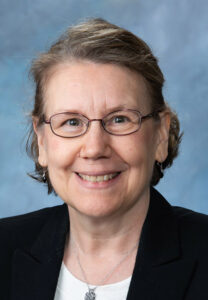By Michele Kueter Petersen
SAU Theological Perspective

The patristic tradition of the early Church is a rich source of wisdom, which in its pairing with sacred Scripture can help guide us in our Lenten spiritual journey. Gregory of Nyssa (CA. 335-395), one of the three Cappadocian Fathers in Eastern Christianity (along with his brother, Basil the Great, and a friend, Gregory of Nazianzen), relates the story of “The Life of Moses.” The first part of his exemplary work is a narrative history and a story of human striving to live a virtuous life. The dynamic of spiritual growth is synonymous with living this life: “For the perfection of human nature consists perhaps in its very growth in goodness” (I.10). He refers to Scripture as the counselor in this regard (I.11).
The second part of the work is contemplation on the “Life of Moses” in the retelling of his story to explore its hidden meaning. The practice of contemplative prayer passes through what the early ascetic tradition refers to as “apatheia,” or “purity of heart” in the monastic tradition and therefore, true knowledge of the divine, which ultimately leads to freedom and divine presence in love. For Gregory, there is “but one purpose in life: to be called servants of God by virtue of the lives we live” (II.314).
The journey is a passage from light to darkness. Gregory emphasizes three forms — light, cloud and darkness — through which the divine reveals itself using the Book of Exodus. The word of God contains the seeds of new growth and is a dynamism if we have an awareness of and openness to “the impenetrable darkness [and] draw near to God by … [our] faith” (II.315). While the process of growth is brought about in faith and trust while largely shrouded in darkness, deep mystery and silence, it is characterized by movement, yearning and direction. That yearning and desire leads to the polishing of the “Imago Dei” in the human being, who is made in the image of God.
Scripture teaches, “Moses drew near to the thick darkness where God was” (Ex 20:21). Moses journeyed beyond a place into nothing, darkness, and as Gregory points out, into “the unknown and unseen” (II.169). When Moses learns to hear with his heart, there is “knowledge of the divine power” that emerges “from the contemplation of reality” such that “he is led by it to the place where his intelligence lets him slip in where God is,” which Scripture calls darkness (II.169).
Moses draws closer to the divine and encounters God in this darkness, experiencing God in love. Moses does not cease in his ascent nor set a limit for his growth. As he climbs the ladder, he asks to attain not with respect to his capacity, but in accordance with true being. This experience seems to belong to those who love what is beautiful. Gregory is instructive in that there is a way in which “hope always draws the soul from the beauty which is seen to what is beyond, always kindles the desire for the hidden through what is constantly perceived” (II.231; II.231n312).
We can glean much from the experience of Moses in cultivating the spiritual life. First, we cannot think, imagine or wish ourselves into the holy darkness; we encounter this awareness of God. No amount of discipline or routine will provide us with this awareness. We must be committed to ever-greater growth. Second, the darkness is ineffable, it is silence, it is inexplicable and apophatic, which is to say one can say nothing about it! Third, the darkness contains ever-greater mystery and is the context in which growth occurs.
Moses had to be cajoled by God to lead the people out of Egypt. Incredulous of God’s request, “Moses said to God, ‘Who am I that I should go to Pharaoh, and bring the Israelites out of Egypt?’ He said ‘I will be with you …’” (Ex 3:11-12). We are reminded that faith and trust in the mission of being sent are required as part of the process and give us the capacity to move into the darkness where true growth occurs.
Mediated by faith and trust, God at once conceals and reveals who God is in saying, “I am who I am” (Ex. 3:14). The yearning for growth in the spiritual life is a yearning for fulfillment, completion, wholeness; it is a yearning for the restoration of the image of beauty in our humanity. Gregory referred to Moses’ life as “a pattern of beauty” (II.319) and traces its outline “so that each one of us might copy the image of the beauty which has been shown to us by imitating his way of life” (II.319).
The request of desire is to enjoy Beauty not reflected, but face to face. The voice of God granted the request precisely through the denial of it. For God agreed to fulfill the desire of Moses without promising that the satiety of desire would cease. Thus, the true sight of God consists in the fact that one who searches for God never gives up that desire.
What Moses longs for is met by what remains unsatisfied in terms of his desire. There is the growth of desire for what is yet going to come in terms of the Good. The ascending occurs by way of the standing, as “the firmer and more immovable one remains in the Good, the more he progresses in the course of virtue” (II.243). The good follows good rather than looking it in the face. Here Gregory teaches the notion of “epektasis:” to pursue God continuously is what it means for us to delight in the divine presence. May our Lenten journey be inspired by the Beauty of the hidden One who loves us into ever-more full life and being.
(Michele Kueter Petersen, Ph.D. is a faculty member in the Theology and Philosophy Department of St. Ambrose University in Davenport.)








